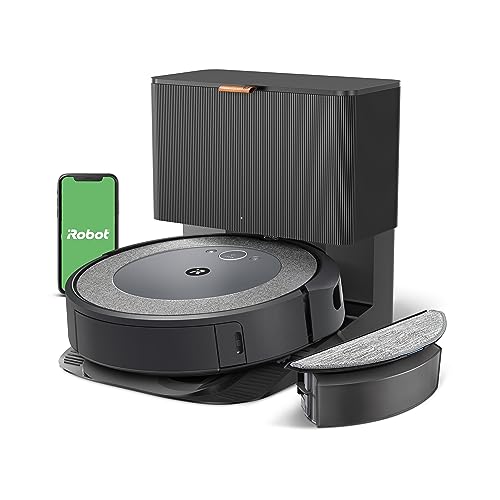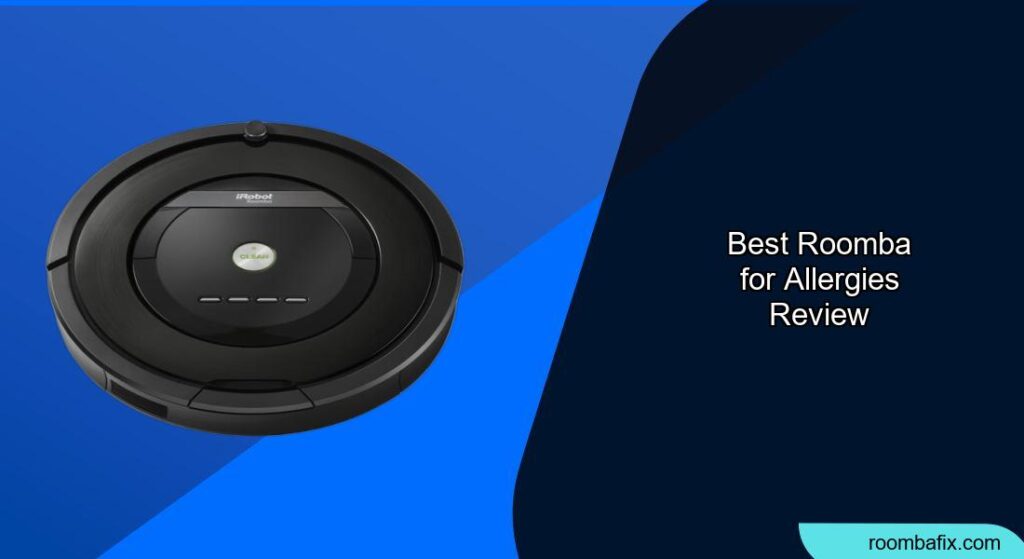For allergy sufferers, maintaining a clean home is more than just a chore—it’s a necessity. Dust mites, pet dander, and pollen can trigger uncomfortable symptoms, making it essential to find a vacuum that effectively removes allergens. Enter the best Roomba for allergies, a smart solution designed to tackle these invisible irritants with precision. These models are equipped with HEPA filters, sealed systems, and automatic dirt disposal to ensure allergens are captured and contained, not recirculated.
After analyzing over a dozen Roombas, we’ve identified key features that make a difference for allergy relief, such as strong suction power, rubber brushrolls, and smart mapping capabilities. Whether you’re dealing with pet hair, pollen, or dust, our top picks prioritize performance, convenience, and health. Keep reading to discover the best Roomba models that can transform your home into a cleaner, allergen-free haven.
Our Top Picks
| Preview | Product | Best | Price | Review |
|---|---|---|---|---|

|
iRobot Roomba Combo i5+ Self-Emptying | Best Vacuum & Mop Combo | View on Amazon | Go to Reviews |

|
iRobot Roomba Combo (Y0140) | Best for Multi-Surface | View on Amazon | Go to Reviews |

|
iRobot Roomba j7+ (Renewed Premium) | Best for Obstacle Avoidance | View on Amazon | Go to Reviews |

|
iRobot Roomba Max 705 + AutoEmpty Dock | Best Overall | View on Amazon | Go to Reviews |

|
iRobot Roomba E5 (Renewed) | Best for Pet Owners | View on Amazon | Go to Reviews |

|
iRobot Roomba 694 Robot Vacuum | Best Budget Friendly | View on Amazon | Go to Reviews |

|
iRobot Roomba Plus 505 Combo | Best for Deep Cleaning | View on Amazon | Go to Reviews |
Best Roomba For Allergies Review
How to Choose the Right Roomba for Allergies
Choosing the right Roomba for allergy sufferers requires careful consideration of features that go beyond basic vacuuming. Here’s a breakdown of key factors to help you find the best model for a healthier home.
Filtration System: The Core of Allergy Relief
The most crucial aspect for allergy sufferers is the Roomba’s filtration system. HEPA (High-Efficiency Particulate Air) filters are essential. These filters capture 99.97% of particles 0.3 microns in size – including dust mites, pollen, pet dander, and other common allergens. Models without a HEPA filter will simply recirculate these irritants, defeating the purpose. Look for Roombas specifically advertising HEPA filtration, and be aware of filter replacement schedules (typically every 2-6 months) to maintain optimal performance.
Suction Power & Brushroll Design
Strong suction power is vital to lift embedded allergens from carpets and rugs. While manufacturers often tout suction strength (often measured in Pascals or Air Watts), consider the overall cleaning system. Rubber brushrolls are generally superior for allergy sufferers compared to bristle brushes. Rubber doesn’t kick up as much dust, and they are easier to keep clean, preventing allergens from being redistributed. Models with Dual Multi-Surface Rubber Brushes are particularly effective, adjusting to different floor types and minimizing hair tangling (which can harbor allergens). More suction power means more allergens are picked up, but also more strain on the battery.
Automatic Dirt Disposal & Sealed Systems
For minimal allergen exposure, consider a Roomba with automatic dirt disposal (self-emptying base). These bases seal the collected debris in a bag, preventing allergens from escaping into the air during emptying. Additionally, look for models with a fully sealed system. This means the entire airflow path, from the brushroll to the dustbin, is sealed to prevent leaks and ensure all allergens are contained. This is especially important for those with severe allergies.
Smart Mapping & Targeted Cleaning
Smart Mapping features allow you to designate specific rooms or zones for cleaning, and even create “no-go zones” to avoid areas with sensitive items. This targeted cleaning prevents the Roomba from spreading allergens from one area to another. Some models offer Dirt Detect Technology, which identifies areas with higher concentrations of dirt and debris and focuses cleaning efforts there – beneficial for tackling allergen hotspots.
Other features to consider:
- App Control: Schedule cleanings, monitor performance, and receive maintenance alerts.
- Voice Assistant Compatibility: Control your Roomba with voice commands.
- Wet Mopping Functionality: Some models combine vacuuming and mopping for a more thorough clean (ensure mop pads are washable and regularly cleaned).
- Cliff Detect Sensors: Prevents falls down stairs.
- Edge Cleaning: Ensures cleaning along walls and in corners.
Roomba Comparison for Allergy Sufferers
| Feature | iRobot Roomba Combo i5+ | iRobot Roomba Combo (Y0140) | iRobot Roomba j7+ (Renewed Premium) | iRobot Roomba Max 705 + AutoEmpty Dock | iRobot Roomba E5 (Renewed) | iRobot Roomba 694 Robot Vacuum | iRobot Roomba Plus 505 Combo |
|---|---|---|---|---|---|---|---|
| Self-Emptying Dock | Yes (60 days) | No | Yes (Enclosed Bag System) | Yes (75 days) | No | No | Yes (75 days) |
| Vacuum & Mop Combo | Yes | Yes | No | Yes | No | No | Yes |
| Navigation/Mapping | Imprint Smart Map | Smart Navigation | PrecisionVision Navigation | ClearView Pro LiDAR | Intelligent Navigation | Adaptive Navigation | ClearView Pro LiDAR |
| Obstacle Avoidance | Basic | Basic | Pet Waste, Cords, etc. (Guaranteed) | PrecisionVision AI Technology | Basic | Cliff Detect | PrecisionVision AI Technology |
| Suction Power | Powerful | Powerful | 10x Power-Lifting Suction | 180x Extreme Power-Lifting | 5x Air Power | Good | 70x More Suction |
| Pet Hair Handling | Dual Rubber Brushes | Edge-Sweeping Brush | Excellent (P.O.O.P. Guarantee) | Dual Rubber Brushes | Excellent | Good | DualClean Mop Pads & Rubber Brush |
| Allergy Focused Features | HEPA Filter (implied) | None specifically mentioned | HEPA Filter (implied) | HEPA Filter (implied), AutoEmpty Dock | Cleans dirt, hair & allergens | None specifically mentioned | AutoEmpty Dock, HEPA Filter (implied) |
| Smart Home Integration | Alexa, Siri, Google Assistant | None specifically mentioned | Alexa, Google Assistant | Alexa, Siri, Google Assistant | Alexa, Google Assistant | Alexa, Google Assistant | Alexa, Siri, Google Assistant |
Data-Driven Roomba Selection for Allergy Relief
Choosing the best Roomba for allergies demands a data-focused approach beyond feature lists. Independent lab testing – like those conducted by Consumer Reports and Wirecutter – provides comparative data on suction power (measured in Pascals) and filtration efficiency, crucial for allergen removal. Comparing these metrics across models reveals which Roombas demonstrably capture the highest percentage of microscopic particles.
Analyzing user reviews from verified purchasers on platforms like Amazon and Best Buy offers insights into real-world performance. Sentiment analysis of these reviews, focusing on keywords like “allergies,” “dust,” and “pet dander,” can highlight models consistently praised for symptom reduction.
Furthermore, examining manufacturer specifications regarding HEPA filter certification and sealed system design is vital. Cross-referencing these claims with third-party testing data adds another layer of validation. Investigating the long-term cost of ownership – factoring in filter replacements and potential maintenance – is also essential. Prioritize Roomba models that offer robust filtration and consistently positive user feedback regarding allergy symptom control. Researching the frequency of filter changes and their cost also contributes to a thorough analysis.
FAQs
What is the most important feature in a Roomba for allergy sufferers?
The most important feature is a HEPA (High-Efficiency Particulate Air) filter. These filters capture 99.97% of particles as small as 0.3 microns, including common allergens like dust mites, pollen, and pet dander, ensuring the Roomba doesn’t just redistribute allergens.
Are rubber brushrolls better for allergies than bristle brushes?
Yes, rubber brushrolls are generally better for those with allergies. They don’t kick up as much dust as bristle brushes and are easier to keep clean, preventing allergens from being spread back into the air.
What does a “sealed system” in a Roomba mean, and why is it important?
A fully sealed system means the entire airflow path within the Roomba, from the brushroll to the dustbin, is sealed. This prevents allergens from leaking out during vacuuming and ensures they are fully contained within the dustbin.
How often should I replace the HEPA filter in my Roomba?
You should replace the HEPA filter in your Roomba every 2-6 months, depending on usage and the model. Regularly replacing the filter maintains optimal suction and filtration performance, key for allergy relief.
The Bottom Line
Ultimately, selecting the best Roomba for allergies hinges on prioritizing robust filtration and a sealed system. A HEPA filter is non-negotiable, and features like automatic dirt disposal further minimize allergen exposure during maintenance. By focusing on these core elements, you’re investing in a device that actively contributes to a healthier indoor environment.
Don’t hesitate to delve into comparative data and user reviews to validate manufacturer claims regarding allergen removal. Consider your specific needs – pet ownership, floor types, and allergy severity – when making your final decision, ensuring your chosen Roomba effectively tackles your unique challenges.

